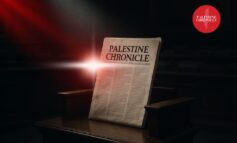The fact that the son of The New York Times’ Jerusalem bureau chief Ethan Bronner is serving in the Israeli military has highlighted an issue that should have been in the spotlight long ago. Ali Abunimah makes some important points about the NYT’s coverage of the Middle East on the Mondoweiss site. Although the paper has a Palestinian reporter in Gaza, Abunimah notes:

|
|
The New York Times’ Jerusalem bureau chief Ethan Bronner. |
Abunimah is right: there is a very strong assumption among editors in the Western media about who should be allowed to cover the Israeli-Palestinian conflict and in what ways. But actually the bias in the Western media runs much deeper than Abunimah allows.
Those who seek to defend Bronner’s continued posting in Jerusalem, despite the obvious – some might say, ultimate – conflict of interest, argue that there are at least as many, if not more, Palestinian journalists covering the region for the Western media as there are Jews and Israelis. That may be true in a literal sense but, because the argument implies that Palestinian journalists are the ones shaping the news agenda, it is entirely misleading. It ignores the reality of how Western news organizations operate in places such as the Middle East. Inadvertently, Abunimah risks creating much the same impression with his reference to Taghreed Khodary’s reporting from Gaza — a posting that can be credited not to the NYT’s policy of diversity among its reporting staff but to the simple fact that Israel’s severe restriction on journalists entering the Strip has left the paper with little choice but to hire one of the “natives.”
What needs emphasizing is that Palestinians working for the Western media do not have anywhere near the same standing, or influence, as reporters like Bronner or his Jewish-Israeli colleague in Jerusalem, Isabel Kershner. The vast majority are essentially gofers, even if there is a discernible hierarchy: some are known as “fixers” because they speak the local language, have good contacts, and can set up meetings and translate for the star reporter; others, working for the wire agencies, are fact-collectors (often known as “stringers”), sending information from their localities that is then processed in the bureau’s head office in Jerusalem or Tel Aviv; and finally there are a tiny number of very lucky Palestinians, called “super-stringers,” like Khodary, who get a mention in the byline.
In all these examples the Palestinian reporters have no meaningful control over the news agenda of the media outlet that employs them. That agenda is set either by the imported star reporter or by the editors far away in head offices in New York, Washington, London, and so on. That relationship of master-servant is clearest in the case of the fixer, whose job is to arrange whatever it is that the star reporter wants.
Similarly, the wire agencies rely on dozens of Palestinian fact-collectors, or stringers, dotted all over the West Bank and Gaza to supply them with a constant flow of local stories. A stringer might send a tip-off to his editors that a tank has just fired at a building in his village, killing a family of five. He will get the victims’ names and ages, and maybe provide a brief description of what happened, and phone it in to the head office. Often there will be little or no interest, or it will be run as small news item (a brief) offering nothing more than the bare facts. If there is more interest, it will probably be written, or “packaged,” by a reporter or editor in the head office, in Jerusalem or Tel Aviv, usually heavily staffed with Israelis and / or Jews. The editors, for example, decide if the firing of the tank shell is to be described as an act of “provocation” or “retaliation.” We know from experience which description they usually prefer.
The story reaches the pages of the NYT only if it fits its news agenda or if it is related to something the star reporter is covering. Again, how these facts are presented to the outside world is almost entirely outside the control of the fact-collector.
Similarly, super-stringers like Khodary have limited influence over the news process in which they take part. To have reached the status of super-stringer, they must have shown that they understand very precisely what is expected of them, what language is used (eg. “fence” or “wall”; “illegal settlement” or “disputed neighborhood”), what stories are covered and which angles are preferred. In most cases, they will be told what story the editors want from them rather than initiate the story. Their job is often to retell a report from the wire agency, using their own contacts and knowledge to give “added value.” In the main, this is quite unlike Bronner’s role: usually he will advise his editors which topics are important and select his own angles. The difference of status between the “star reporter” and the “super-stringer” is similar to that between a tenured professor and a supply teacher.
A further point worth noting is that Abunimah’s list of recent Jewish / Israeli reporters covering the conflict for the NYT is, as far I know, not exhaustive. My impression is that most of the NYT’s senior reporters over the past two decades have been Jewish or Israeli. Like Abunimah, I am uncomfortable judging a journalist’s record of reporting based on his or her ethnic identification. But these scruples should not blind us to the danger that the apparent long-term structural bias in the NYT’s selection processes may have contributed significantly to distorting Western understanding of what is going on in the conflict. The consistent favoring of Jewish reporters for the Israeli-Palestinian beat needs explaining by the editors of the NYT. This is especially true given my first point about the lack of Palestinian, or Arab, reporters who have any real input into the newsgathering processes of the Western media.
Should there not be concerns about balance, or the appearance of balance, in simple quantitive terms in the NYT’s selection of reporters dealing with such a contested subject? If there are two senior reporting posts at the NYT’s Jerusalem bureau, is it defensible to have them both occupied by Jews and / or Israeli Jews? If Jews are better able to use their connections to cover Israeli and Jewish issues (one argument being put forward), is not the converse true? Would Palestinians not be able to cover some issues in the conflict more authentically and convincingly than Jewish reporters? Should Jews be restricted to covering Israeli stories, and Palestinians to covering Palestinian stories? And if we recoil from that thought, what does that tell us about the current reality in which only Israelis and Jews get to set the news agenda at the NYT (and many other media) for both sides of the conflict?
It is about time we saw a little more transparency and self-reflection from the editors of The New York Times.
Jonathan Cook is a British journalist. His articles can be found in a number of major international newspapers. His most recent books are “Disappearing Palestine: Israel’s Experiments in Human Despair” and “Israel and the Clash of Civilizations: Iraq, Iran and the Plan to Remake the Middle East.” Source: www.jkcook.net





Leave a Reply